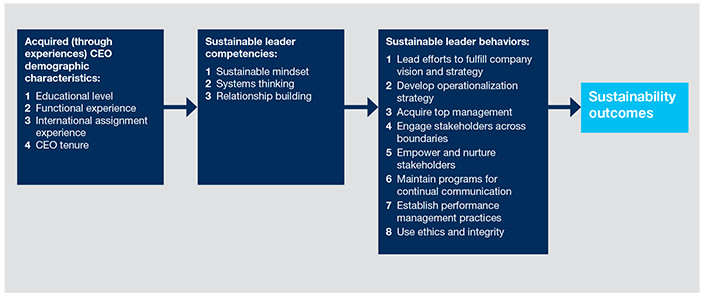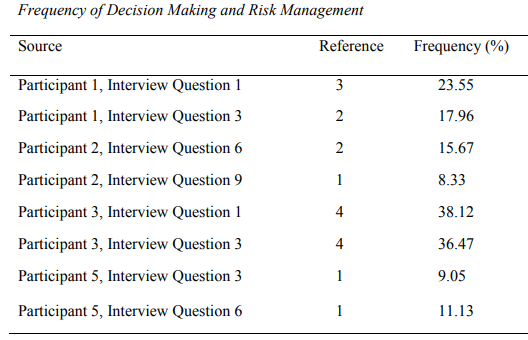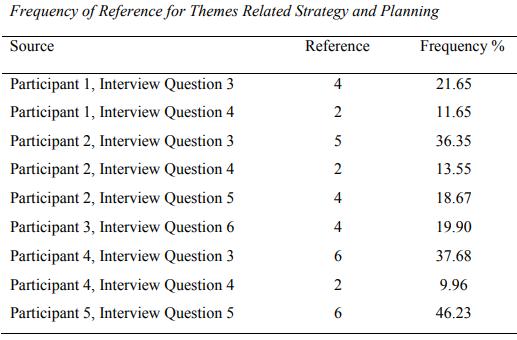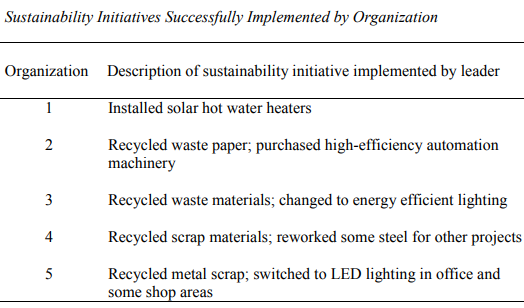Abstract
Medium and small enterprises play a cortical role in the development of the global economy as they cater for about 80% of the financial provision. In order to ensure that the figures and percentage are boosted, there is need to implement strategies that lead to sustainable growth. It is approximated that by 2030, about $5 trillion will have been availed in an effort to achieve an international sustainable growth environment for all enterprises. This study is based on qualitative analysis of various small businesses in different parts of the world that had managed to incorporate sustainable methods. It also relies on leadership competency hypothesis. Information for the research was obtained by conducting in-depth interviews and going through various organizational documents that are normally employed in the process of planning. Enterprise plans were collected, cross-analyzed, coded and re-checked on a periodical basis for the purpose of ensuring that the research interpretations were highly credible. Six factors that affect sustainable as a result of implementing competent leadership policies will be identified by the report. As proposed by Ziek and Smulowitz (2014), the consequences of wanted social alterations constitute of factors that can enable enterprise leaders to create strategies that are sustainable. The focus of these factors will also be directed towards implementing actions that are environmentally sustainable within the premises of the organizations.
Introduction
The exhaustion of naturally occurring resources as a result of undertaking business activities has been a concern that is continually gaining momentum as it is considered to be primary environmental, business and social factor. In the past decade, creating sustainable businesses has been continually taken up in various sectors of the economy. Since the release of WCED’s reports with regards to Bruntland Report, sustainable development and sustainability have increasingly been employed when talking about enterprises that try to curtail the extended negative effects of conducting business operations on the natural resources. According to Boyatzis (2011), two factors determine the success of any enterprise. They include mentoring leadership competencies that they can understand more that is related to sustainability and fulfilling expectation of stakeholder on the basis of environmental, social, and economic responsibility (Elliot, 2013).
Relationship between Leadership Development and Capacity Graph
Success if creating and successfully executing plans in order to achieve the creation of a sustainable environment for the business is fully dependant on the informed decision-making approaches that augur well with enterprise goals and mission. Numerous literature materials have published reports on the effectiveness of implementing strategic approaches in a business environment as such an action leads to the development of greater returns for any business. Likewise, implementation of similar sustainable techniques that stems from well-informed leadership approaches will lead to greater returns for medium and small businesses, in the end, they will end up accounting for more than the approximated 75% value (Wingwon, 2012). Therefore, evaluating the competencies of leaders in the small and medium-sized companies so that they can be able to take up strategies that enable the achievement of sustainable development is the objective of this report.
Assumptions
Every research process does not lack bias and this comprises of the set of preconceived expectations that a researcher brings to table prior to engaging in the research. In this case, two assumptions that have been made include the notion that the literature material that was first employed in the research process could be applicable to all types of enterprises. The second assumption was that most enterprise has implemented sustainable policies in their enterprises and they may know less about the leadership competencies. Finally, an assumption had been made that a successful implementation of leadership competency in one organization could be taken up by other organizations and lead to successful outcomes.
Limitations
The limitations of the research can be based on reliability, transferability, and validity. According Jackson (2016), limitations can be based on events, shortcomings, conditions, and events. Since it is impossible for a researcher to manage qualitative attributes of a study, it is essential to recognize and embrace the possible limitations that may exist. The first challenge revolves around the geographical location of the area in which the research was supposed to be conducted. The second limitation was based on the selection of enterprise leaders who had managed to successfully implement sustainable methods. Finally, this research focused on acquiring information about implementation of sustainable environments through leadership competency. Information about failed efforts to implement sustainable environmental strategies due to the lack leadership competencies was not reviewed due to its exiguous nature of such data.
A Review of the Professional and Academic Literature
The objective of the undertaking was to provide insight about major competencies that are essential toward the successful implementation of sustainability approaches in enterprises. An analysis of professional and academic materials was meant to ensure that the reviewer of this report could be able to get a clear overview of how this study can be incorporated into literature materials that have already been developed by other authors(Wiek, Withycombe, & Redman, 2011). The literature review provides a solid platform for starts and progressing this research undertaking. Using the literature review, it was possible to analyze the relevance and quality of data sources related to investigating the problem. Additionally, the literature review played a role in the development of a suitable conceptual framework, hence enabling the capture of a huge amount of information into an easy to read and understand summary. Previous researchers on the issues have managed to indicate the ability of apt enterprise leaders in becoming successful (Cici & D’Isanto, 2017, p.60).
Leadership Characteristics that lead to Sustainability
Leadership competency is a main area of interest for this research process as it enables the successful incorporation of sustainable practices. Researchers continue to explore and teach leadership competency with the intention of boosting the skills of enterprise leaders (Kerr, 2006). Initial studies about leadership competency were kick-started by psychologists who were involved in undertaking job analysis and designs. Former scholar focused mainly on the isolation of attributed that were possessed by successful managers (Boyatzis, 2011). Even now, research continues to be undertaken with regard to the outstanding qualities that can be associated with a successful leader. They have been outlined to be competency and emotional intelligence, and cultural know-how (Lado, & Wilson, 1994). As time progresses, competency is continually being used to describe job positions and eventually be used to assess the performance of individuals using frameworks for competency modeling. According to scholars, the use of a specific set of skills that are attached to leadership responsibilities and duties can easily lead to the development of an advanced enterprise performance models (Owie, 2017).
One of the most significant challenges that continue to affect enterprises is the challenge of implementing sustainable practices. Leaders try to implement sustainability, however, due to lack of the technical know-how and experienced, they mostly end up failing. Porter (1991), identified that as the capability of an enterprise to fulfill the needs of the current society while avoiding to interfere with the resources that can be used to satisfy the needs of the future societies. The definition is the only one that has been accepted and implemented in various researches undertakings.
Participants
Research participants for such a research process should show proximate relation to the process and the answers that are being sought. Such is the basis of any expiratory research. In this case, company leaders who have successfully set up sustainability initiatives were considered as the main research participants. Like more consideration as given to leaders who have exhibited greater competency tendencies that were needed to implement sustainable approaches in their organizations.
Research Method and Design
Data analysis for analyzing leadership competency was achievable by implementing qualitative analysis approach. By using such a method, it becomes possible to gain greater knowledge through an exploration of the in-depth context that is associated with the research participants. The use of qualitative technique enables the researcher to gain a better understanding of phenomena that occurs naturally and within a specific environment. It also enhances better storage of information. Combining qualitative analysis and multiple case analysis approach needed a systematized data gathering and interview method (Rimanoczy & Pearson, 2010). Additionally, it will require a comprehension of limitations and boundaries for each unit case for distinction purposes.
Findings
The primary question in research was how can leadership competency be employed in the process of implementing sustainability within enterprises? Based on an in-depth analysis of the enterprise industry, the following three themes that are strongly associated with leadership competency came to light.
Decision Making
Zimmerman (2014), suggests that the ability to make correct decisions is critical for any business and this aspect creates a strong interlink between company viability and decisions especially when an enterprise has just been incepted. The manner in which decisions are made determines how the business will survive on the long term (Thomason, Simendinger, & Kiernan, 2013). Wrong decisions can be used as a reference point for making proper decisions in future.
Strategy and Planning
Achieving environmental sustainability requires critical planning. The planning process may be faced by time limitation as there is need to ensure that business continuity is sustained. However, Wesselink et al (2015), when tasks are delegated for different departments, time will be created for creating proper enterprise plans. Most leaders don’t have actual written plans and this tends to hamper effort to achieve sustainability.
Environmental sustainability
Attaining environmental sustainability depends on the definition that is associated with success in the business. Depending on the managers view, a successful sustainability measures may include, cost reduction, waste re-usual, and throughput improvement (Tollin & Vej, 2012 p.626). Therefore, based on what may need to be achieved within a particular enterprise, leadership competencies may end up being learned only to a particular point. However, only the most successful leaders can be able to see the larger picture of implementing sustainability to its fullest (Williams, & Schaefer, 2013).
Implications for Social Change
As identified earlier, the operations for the Small and medium enterprise account for the percentage of the undertaking that is made by all types of firms in the world. Likewise, the forms of businesses account for the largest part of employment provision and the figure stands at 40%-60%.In this case, improved techniques of planning ought to be taken up by the aforementioned enterprise leaders so that the above figures can be further improved. When the percentages go high, the better opportunities will be created for employment seekers and business development in general (Takács & Matkó, 2014). With regards to the environment, the rate of pollution will be curtailed, recycling process will be boosted and environmental resources will end up being conserved, hence creating a sustainable environment for the future. Using proper planning and strategies, and analyzing leadership competency that is taken up by a business as derived from firms in Nebraska can help other enterprises to successfully boost the quality of the environment in which they operate. Based on this study’s findings, competency could be employed by leaders in the form of ensuring that a business partners with the local society (Thach & Thompson, 2007). Findings of this study show the leadership principles that are essential in creating and implementing sustainable undertakings. Organizations that suffer from a lack of leadership competency could really benefit from implementing the recommendation that is provided by this research. Likewise, societal leaders that intend to resources within the environment in their locality, develop green jobs, create regulation templates, and boost economic chances could also gain from the findings of this research (Tehseen &Ramayah, 2015).
Recommendations for Action
Business enterprises that have not implemented sustainable approaches due to leadership competency, should implement results from this research undertaking. On the other hand, I insist on the need for organizations from Nebraska Small Business community Development Center to incorporate materials for training for the purpose of helping a leader who is interested in learning all that is associated with leadership competency. Likewise, workshop programs should be implemented so as to coach groups on sustainability (Simonet & Tett, 2013).
Leadership Development Graph
Organizations should come up with curricula’s for developing sustainability. With the advancement of technological innovation, it is essential to create a data repository where in-depth information about sustainability leadership competency can be accessed by anyone should be developed.
Recommendations for Further Research
The objective of this research report was to investigate the primary competency that can be implemented by business leaders so that a sustainable environment can be developed. General Findings of the research process indicate that the leadership competencies that have already been established by sustainable organizations are applicable to an organization in other regions of the world so that positive results will be obtained. Research materials that have been previously published by other authors Tripathi and Bains (2013), come up with similar results. However, the absence of a business plan appears to be consistent all types of research materials. It is, therefore, my recommendation that extensive research is done with regard to how leadership competency and enterprise planning leads to greater success in an achieving a sustainable environment.
Future research on actualizing advanced environment and sustainability methods as a result of using actual leadership competency by employing quantitative exploration may help to offer better insight of the nature of a successful leadership competency (Westrenius & Barnes, 2015). Additionally, future research should be directed towards understanding how certain strategies enable the implementation of advanced environmental incentives and initiatives so that better awareness can be created.
Reflection
The chance to undertake a research on the leadership competencies that are required to achieve a sustainable environment has offered me great opportunities of understanding how enterprises implement their strategies and the experience that I have had in the process was intensive. Prior to the research, I expected to gain a ton of knowledge on the challenges that were associated with managing manufacturing enterprises and that I achieve through the interview session that I conducted. While conducting the interviews, I was awed by the extensive information that enterprise leaders possess with regards to creating a sustainable company environment.
Conclusion
Since we exist in a world of resources that can easily be depleted, creating an environmentally sustainable business is critical. The man challenge that is encountered by today’s leaders in the process of creating a sustainable environment is the lack of appropriate leadership competencies. As a result, the initiative of such manager ends up failing. Additionally, there are few stakeholders who are willing to coach business leaders on how the can develop the necessary leadership competencies (Vázquez-Carrasco & López-Pérez, 2013). The information is associated with the development of sustainable environment is intensively fragmented. The situation is due to the lack of a consolidated information point where knowledge can be intensively gained. Leadership competency development is not an easy process as it requires proper education, practice, and experience (Wang, & Zhang, 2014). As much as huge efforts have been directed towards the education of enterprise leaders so that they can gain knowledge about environmental sustainability, the challenges hindering the process are ever growing. I propose for the development of a model for learning leadership competency and how sustainable strategies can be implemented. By doing so, the stakeholder will be able to reach more leaders and provide them with a template that they can use to learn leadership competency (Stevens, 2013). In the end, business leaders will be able to boost the state of environmental sustainability associated with their companies and gain a better competitive advantage.
References
Boyatzis, R.E., 2011. Managerial and leadership competencies: A behavioral approach to emotional, social and cognitive intelligence. Vision, 15(2), pp.91-100.
Cici, C. and D’Isanto, D., 2017. Integrating Sustainability into Core Business. Symphonya. Emerging Issues in Management, (1), pp.50-65.
Jackson, A.W., 2016. Core Leader Competencies for Implementing Sustainability Strategies in Small and Medium-Sized Enterprises (Doctoral dissertation, Walden University).
Kerr, I.R., 2006. Leadership strategies for sustainable SME operation. Business Strategy and the Environment, 15(1), pp.30-39.
Lado, A.A. and Wilson, M.C., 1994. Human resource systems and sustained competitive advantage: A competency-based perspective. Academy of management review, 19(4), pp.699-727.
Owie, E., 2017. The Imperative of the Corporation and Socially Conscious Leadership. Journal of Social Change, 9(1), p.14.
Porter, M.E., 1991. Towards a dynamic theory of strategy. Strategic management journal, 12(S2), pp.95-117.
Rimanoczy, I. and Pearson, T., 2010. Role of HR in the new world of sustainability. Industrial and Commercial Training, 42(1), pp.11-17.
Takács, T. and Matkó, A., 2014. Examination of roles, tasks and management competencies of moderators through a kaizen analysis. International Review of Applied Sciences and Engineering, 5(1), pp.79-89.
Tehseen, S. and Ramayah, T., 2015. Entrepreneurial competencies and SMEs business success: The contingent role of external integration. Mediterranean Journal of Social Sciences, 6(1), p.50.
Thach, E. and Thompson, K.J., 2007. Trading places: Examining leadership competencies between for-profit vs. public and non-profit leaders. Leadership & Organization Development Journal, 28(4), pp.356-375.
Tripathi, A. and Bains, A., 2013. A Study of Indian CSR practices in small and medium enterprises.
Tollin, K. and Vej, J., 2012. Sustainability in business: understanding meanings, triggers and enablers. Journal of Strategic Marketing, 20(7), pp.625-641.
Thomason, S.J., Simendinger, E. and Kiernan, D., 2013. Several determinants of successful coopetition in small business. Journal of Small Business & Entrepreneurship, 26(1), pp.15-28.
Simonet, D.V. and Tett, R.P., 2013. Five perspectives on the leadership–management relationship: A competency-based evaluation and integration. Journal of Leadership & Organizational Studies, 20(2), pp.199-213.
Stevens, G.W., 2013. A critical review of the science and practice of competency modeling. Human Resource Development Review, 12(1), pp.86-107.
Vázquez-Carrasco, R. and López-Pérez, M.E., 2013. Small & medium-sized enterprises and C Corporate Social Responsibility: a systematic review of the literature. Quality & Quantity, 447(6), pp.3205-3218.
Wang, D., Waldman, D. A., & Zhang, Z. (2014). A meta-analysis of shared leadership and team effectiveness. Journal of Applied Psychology, 99, 181-198. doi:10.1037/a0034531
Westrenius, A. and Barnes, L., 2015. Managing complex business relationships: Small business and stakeholder salience. The Journal of Developing Areas, 49(6), pp.481-488.
Wesselink, R., Blok, V., van Leur, S., Lans, T. and Dentoni, D., 2015. Individual competencies for managers engaged in corporate sustainable management practices. Journal of Cleaner Production, 106, pp.497-506.
Wingwon, B., 2012. Effects of entrepreneurship, organization capability, strategic decision making and innovation toward the competitive advantage of SMEs enterprises. Journal of Management and Sustainability, 2(1), p.137.
Wiek, A., Withycombe, L. and Redman, C.L., 2011. Key competencies in sustainability: a reference framework for academic program development. Sustainability science, 6(2), pp.203-218.
Williams, S. and Schaefer, A., 2013. Small and medium‐sized enterprises and sustainability: M Managers’ values and engagement with environmental and climate change issues. Business Strategy and the Environment, 22(3), pp.173-186.
Zimmerman, J., 2014. Toward a hypothesis connecting leadership and entrepreneurship. International Journal of Management & Information Systems (Online), 18(4), p.291.
Ziek, P. and Smulowitz, S., 2014. The impact of emergent virtual leadership competencies on team effectiveness. Leadership & Organization Development Journal, 35(2), pp.106-120.











